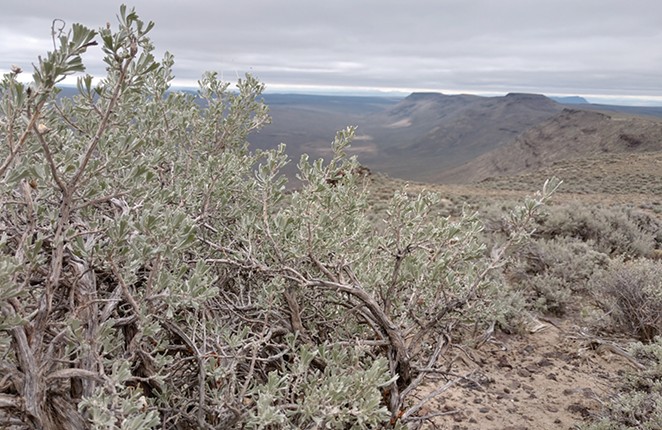In May 2021, I hiked the entire 750-mile-long Oregon Desert Trail, touring the high desert plant communities of central and eastern Oregon on foot. Throughout this otherwise lonely trek, one plant was my constant companion: big sagebrush (Artemisia tridentata Nutt.).
All three of the major subspecies of this aromatic shrub are found in Oregon.
Lower-elevation sites with deeper soils support basin big sagebrush — easily recognizable by its long, thin leaves and tall, leggy growth form.

Found at moderate elevations and where soils are shallower, Wyoming big sagebrush is round and short-statured. This subspecies can extract water from soils too dry for many other plants — including the other big sagebrush subspecies.
Mountain big sagebrush lives at higher elevations where soils are deeper. This subspecies is often flat-topped but can resemble Wyoming big sagebrush. Connoisseurs can tell the two apart by smell, but even a novice can distinguish them by placing a few leaves in water under blacklight. Mountain big sagebrush leaves glow bright blue, thanks in part to the same chemicals that provide their characteristic sweeter smell.
"Sweeter" is perhaps a relative term. Although big sagebrush is an important food source for animals like the greater sage-grouse, pronghorn and mule deer, it is bitter and unpleasant to humans. Note that we often refer to these shrubs as "sage," but this is not the sage used in savory dishes. Big sagebrush belongs to the family Asteraceae, along with sunflowers and daisies. Culinary sage is in the Lamiaceae family, with mint, rosemary and thyme as relatives.
Humans are not the only animals in Oregon to find this plant unpleasant to eat. Nearly all big sagebrush ecosystems support livestock grazing, and cattle prefer a diet that excludes this ubiquitous plant. As a consequence, many extraordinary and imaginative methods have been developed to remove sagebrush in an effort to promote grasses and cater to the bovine palate.
Today, big sagebrush is often considered a valuable part of the landscape rather than a nuisance — and for good reason. These shrubs engineer their habitat in surprising ways that improve conditions for both animals and plants. Big sagebrush promotes water infiltration and helps maintain snowpack. Its robust root system reaches deep into the soil, allowing it to use water that is inaccessible to most other plants — and then share that water. At night, big sagebrush's roots transport water from wetter to drier parts of the soil. This phenomenon, common to many plants, was first discovered in big sagebrush. It's called "hydraulic lift" because the primary direction of this redistribution is up in these ecosystems where sun and wind rapidly dry shallow soils. In addition to enhancing water resources, big sagebrush also concentrates nutrients in the soils directly beneath its canopy, and these "islands of fertility" can promote recovery after fire.
At first glance, landscapes defined by big sagebrush can appear as monotonous grey-green expanses of shrubs surging toward the horizon. But, as you've just learned, several subspecies are growing here, and when you look closer, you'll see a variety of grasses and wildflowers nestled under and among the shrubs.
The way big sagebrush marks the passing of each season is similarly subtle, with slight but important changes that allow it to thrive in its harsh environment. In winter, its evergreen leaves usually remain partially uncovered by snow, allowing it to photosynthesize on warmer days. When water is abundant in the spring, this shrub grows both small, perennial leaves and big, ephemeral leaves to gather and store energy. When temperatures increase and water becomes scarce, big sagebrush sheds the larger leaves and assumes a more frugal affect to wait out the hot, dry summer. At the same time, it shifts its efforts to growing stems that will support hundreds of tiny yellow flowers in the fall. Although this happens when water is scarce, these stems efficiently photosynthesize and can contribute energy to their own growth.
Whenever you find yourself in the company of this stalwart western shrub, keep an eye out for wildflowers (and wildlife) and take note of its seasonal adaptation. As you hike stretches of the Oregon Desert Trail, try to imagine how big sagebrush is quietly engineering the water and nutrients beneath your feet.
—Rachel R. Renne is a PhD student studying big sagebrush ecosystems at the Yale School of the Environment and is a volunteer with Oregon Natural Desert Association, a nonprofit organization that protects and restores Oregon's high desert public lands and waters.








